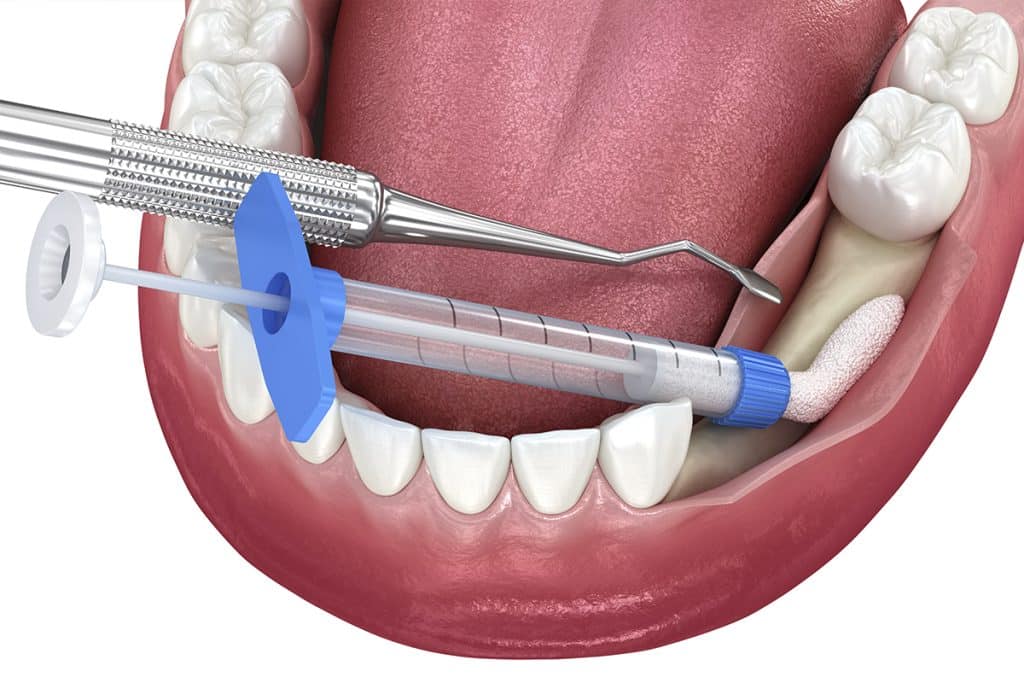How Does Bone Grafting Affect Your Teeth?

Dental bone grafting is an extremely common procedure, with over 2 million dental bone grafts being done in the U.S. alone each year. Dental bone grafts serve several purposes in dentistry and are necessary in certain cases for other dental work to be possible. If this recommendation is made, you probably have a lot of questions.
What is a Dental Bone Graft?
A dental bone graft is a reconstructive oral surgical procedure meant to increase bone density and correct defects in the jawbone. During a dental bone graft, your oral surgeon will add bone material to the existing jawbone in hopes that it successfully integrates with the existing bone and results in a more stable jaw structure.
Who Needs a Dental Bone Graft?
Dental bone grafts can be useful in many different situations. They are commonly done as a result of congenital defects, dental trauma, tooth extractions, or even after the removal of an oral tumor. Dental bone grafts are often needed before other dental work can be done, such as implants or dentures, as these procedures require a certain amount of existing bone structure to be present. Your oral surgeon can help you determine if a dental bone graft would benefit you.
Types of Dental Bone Grafts
There are several different types of dental bone grafts. Firstly, dental bone grafts can be made of four different types of material. Additionally, dental bone graft methods differ depending on their purpose.
Dental Bone Graft Materials
Dental bone grafts can be categorized based on where the donor bone originates:
- Autograft: The donor bone is taken from the patient themself.
- Allograft: The donor bone is taken from another human or a cadaver.
- Xenograft: The donor bone is taken from an animal, usually a cow or pig.
- Alloplast: The donor bone is made of synthetic materials.
- Infuse® Bone Morphogenic Protein: The donor bone is generated using a patented liquid protein substance that is applied to the area where bone growth is needed.
Dental Bone Graft Methods
Dental bone graft methods vary based on the issue being corrected and desired outcome:
- Socket Preservation: Performed immediately after a tooth extraction to preserve the jawbone density and prevent the socket from caving in.
- Ridge Augmentation: Performed to rebuild bone density after teeth have been missing for an extended time, usually in preparation for dental implants or another dental procedure.
- Sinus Lifts: Performed to fortify the upper jawbone while also lifting the sinuses, which may have fallen due to removal of the upper back teeth.
- Periodontal Bone Graft: Performed as a result of gum recession which has left the teeth loose and mobile.
Benefits of Dental Bone Grafts
The main benefit of any dental bone graft is to rebuild and fortify the jawbone structure. Additional benefits include:
- Providing additional support for the teeth and gums
- Supporting dental implants and implant-supported bridges and dentures
- Avoiding a sunken in facial appearance
- Preserving the natural teeth
Risks of Dental Bone Grafts
While dental bone grafts have an incredibly high success rate, they come with risks, just like any dental surgery:
- Infection
- Heavy bleeding
- Nerve damage
- Complications from anesthesia
Your oral surgeon will provide detailed after-surgery instructions to prevent these risks. Be sure to follow these instructions carefully and report any issues to the oral surgeon immediately.
Frequently Asked Questions About Dental Bone Grafts
Are dental bone grafts painful?
Most patients report only minimal discomfort after receiving a dental bone graft, which typically subsides within a few days. It is important to take all the medications, including pain medications, prescribed by the oral surgeon during this recovery period to avoid pain and complications.
How long after a dental bone graft can I get a dental implant?
Every patient is different, but most can have a dental implant done around six months after receiving a dental bone graft. The use of platelet-rich plasma (PRP) during the surgery can help accelerate healing, but not always warranted.
Dental Bone Grafts in Cincinnati
If you have a weakened or diminished jawbone due to missing teeth, trauma, or another medical condition, a dental bone graft may be the best way to restore your jaw structure and prepare you for further reconstructive dental work. For patients in the Cincinnati metro, Oral & Facial Surgery Associates, LLC, offers high-quality dental bone grafting services in a welcoming and professional setting. To schedule a consultation with our board certified oral surgeons, call 513-791-0550, request an appointment online, or have your primary dentist send us a referral.
